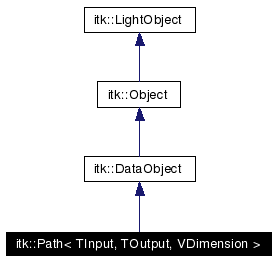
#include <itkPath.h>
Inheritance diagram for itk::Path< TInput, TOutput, VDimension >:


Public Types | |
| typedef Path | Self |
| typedef DataObject | Superclass |
| typedef SmartPointer< Self > | Pointer |
| typedef SmartPointer< const Self > | ConstPointer |
| typedef TInput | InputType |
| typedef TOutput | OutputType |
| typedef Index< VDimension > | IndexType |
| typedef Offset< VDimension > | OffsetType |
Public Member Functions | |
| virtual const char * | GetNameOfClass () const |
| virtual InputType | StartOfInput () const |
| virtual InputType | EndOfInput () const |
| virtual OutputType | Evaluate (const InputType &input) const=0 |
| virtual IndexType | EvaluateToIndex (const InputType &input) const=0 |
| virtual OffsetType | IncrementInput (InputType &input) const=0 |
Protected Member Functions | |
| Path () | |
| ~Path () | |
| void | PrintSelf (std::ostream &os, Indent indent) const |
| virtual OffsetType | GetZeroOffset () const |
| virtual IndexType | GetZeroIndex () const |
This base class is intended to represent a path through an image. As a path, it maps a 1D parameter (such as time or arc length, etc) to an index (or possibly an offset or a point) in ND space. This mapping is done via the abstract Evaluate() method, which must be overridden in all instantiable subclasses. The only geometric requirement for a gerneral path is that it be continuous. A path may be open or closed, and may cross itself several times. A classic application of this class is the representation of contours in 2D images using chaincodes or freeman codes. Another use of a path is to guide the movement of an iterator through an image.
Definition at line 51 of file itkPath.h.
|
|||||
|
|||||
|
All paths must be mapable to index space Reimplemented in itk::ChainCodePath< VDimension >, itk::ChainCodePath2D, itk::FourierSeriesPath< VDimension >, itk::OrthogonallyCorrected2DParametricPath, itk::ParametricPath< VDimension >, itk::PolyLineParametricPath< VDimension >, itk::ChainCodePath< 2 >, and itk::ParametricPath< 2 >. |
|
|||||
|
|||||
|
|||||
|
|||||
|
|||||
|
Standard class typedefs. Reimplemented from itk::DataObject. Reimplemented in itk::ChainCodePath< VDimension >, itk::ChainCodePath2D, itk::FourierSeriesPath< VDimension >, itk::OrthogonallyCorrected2DParametricPath, itk::ParametricPath< VDimension >, itk::PolyLineParametricPath< VDimension >, itk::ChainCodePath< 2 >, and itk::ParametricPath< 2 >. |
|
|||||
|
|||||||||
|
|
|
|||||||||
|
|
|
|||||||||
|
Where does the path end (what is the last valid input value)? This value is sometimes used by IncrementInput() to go to the end of a path. Reimplemented in itk::ChainCodePath< VDimension >, itk::OrthogonallyCorrected2DParametricPath, itk::PolyLineParametricPath< VDimension >, and itk::ChainCodePath< 2 >. |
|
||||||||||
|
Evaluate the path at specified location along the path. Return data is the path's "natural" format. Implemented in itk::ChainCodePath< VDimension >, itk::ChainCodePath2D, itk::FourierSeriesPath< VDimension >, itk::OrthogonallyCorrected2DParametricPath, itk::PolyLineParametricPath< VDimension >, and itk::ChainCodePath< 2 >. |
|
||||||||||
|
Like Evaluate(), except always returns an index Implemented in itk::ChainCodePath< VDimension >, itk::ChainCodePath2D, itk::ParametricPath< VDimension >, itk::ChainCodePath< 2 >, and itk::ParametricPath< 2 >. |
|
|||||||||
|
Run-time type information (and related methods). Reimplemented from itk::DataObject. Reimplemented in itk::ChainCodePath< VDimension >, itk::ChainCodePath2D, itk::FourierSeriesPath< VDimension >, itk::OrthogonallyCorrected2DParametricPath, itk::ParametricPath< VDimension >, itk::PolyLineParametricPath< VDimension >, itk::ChainCodePath< 2 >, and itk::ParametricPath< 2 >. |
|
|||||||||
|
|
|
|||||||||
|
|
|
||||||||||
|
Increment the input variable passed by reference such that the ND index of the path moves to its next vertex-connected (8-connected in 2D) neighbor. Return the Index-space offset of the path from its prior input to its new input. If the path is unable to increment, input is not changed and an offset of Zero is returned. Children are not required to implement general bounds checking, but are required to return an offset of zero when trying to increment from the final valid input value. Implemented in itk::ChainCodePath< VDimension >, itk::ChainCodePath2D, itk::ParametricPath< VDimension >, itk::ChainCodePath< 2 >, and itk::ParametricPath< 2 >. |
|
||||||||||||||||
|
Methods invoked by Print() to print information about the object including superclasses. Typically not called by the user (use Print() instead) but used in the hierarchical print process to combine the output of several classes. Reimplemented from itk::DataObject. Reimplemented in itk::ChainCodePath< VDimension >, itk::ChainCodePath2D, itk::FourierSeriesPath< VDimension >, itk::OrthogonallyCorrected2DParametricPath, itk::ParametricPath< VDimension >, itk::PolyLineParametricPath< VDimension >, itk::ChainCodePath< 2 >, and itk::ParametricPath< 2 >. |
|
|||||||||
|
Where does the path begin? For most types of paths, the path will begin at zero. This value can be overridden in children, and is necessary for iterators to know how to go to the beginning of a path. Reimplemented in itk::OrthogonallyCorrected2DParametricPath. |
 1.3.5 written by Dimitri van Heesch,
© 1997-2000
1.3.5 written by Dimitri van Heesch,
© 1997-2000